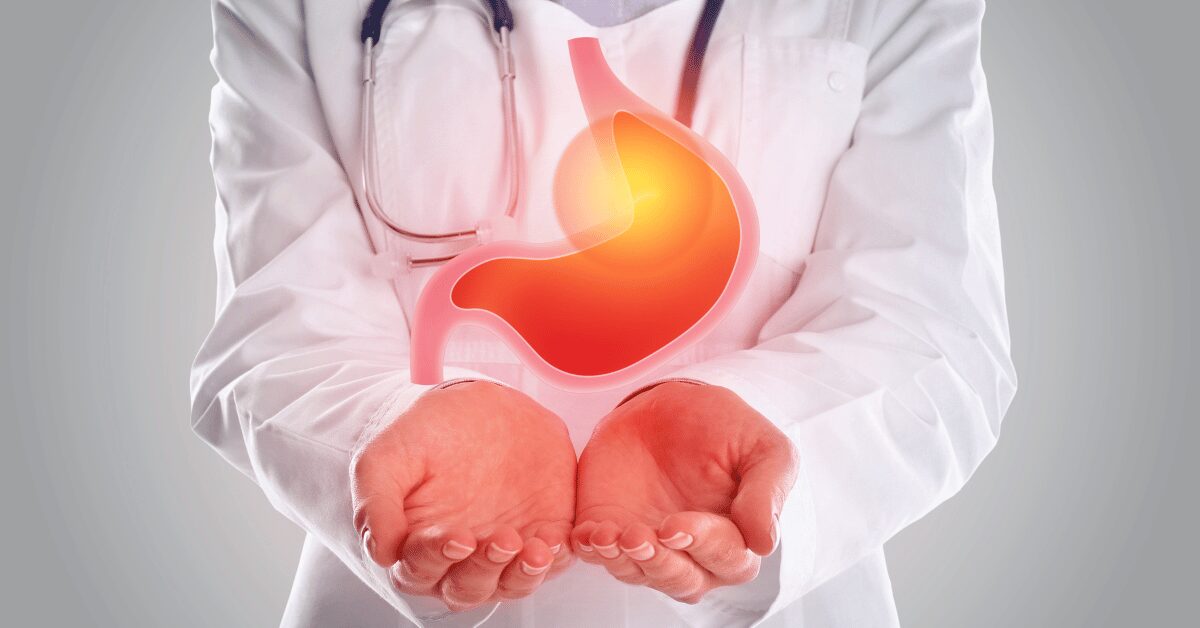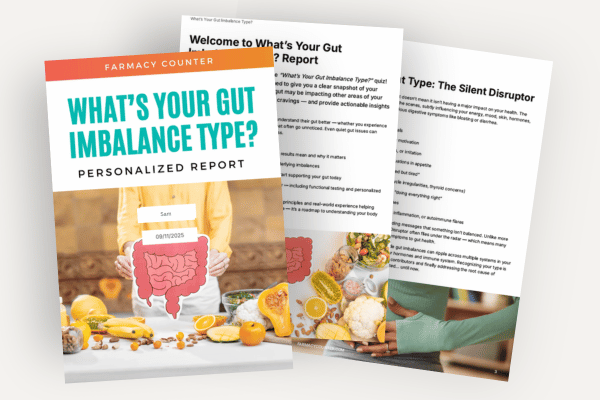
If you’re struggling with bloating, heartburn, fatigue after meals, or seeing undigested food in your stool, you might assume these are just normal parts of getting older or signs of a “sensitive stomach.” But what if I told you these symptoms often point to something you’d never expect: not enough stomach acid?
In functional medicine, we see this pattern constantly—people who’ve been told they have too much acid when the real issue is too little. Understanding how stomach acid works (and why it matters so much) can be the key to finally resolving digestive issues that may have plagued you for years.
The Surprising Truth About Heartburn and GERD
If you’ve been dealing with acid reflux or heartburn, you’ve probably been told you have too much stomach acid. Here’s what might surprise you: the problem is often the exact opposite. Many people experiencing reflux actually have insufficient stomach acid, and the acid they do have is simply ending up in the wrong place.
Think of your stomach as a tightly sealed container meant to hold very acidic contents. When everything’s working properly, that acid stays put and does its job. But when acid production drops, several things happen: food sits in your stomach longer, pressure builds up, and whatever acid is present can be pushed upward into your esophagus where it definitely doesn’t belong. The sensation is the same—that burning feeling—but the root cause is completely different.
Why Your Stomach Acid Matters More Than You Think
A healthy stomach maintains an impressively acidic environment with a pH between 1.0 and 2.5. This isn’t just for breaking down your lunch—it’s essential for:
Nutrient Extraction: Strong stomach acid breaks apart proteins into amino acids (the building blocks for hormones, neurotransmitters, and tissue repair), separates minerals like iron, zinc, and magnesium from food, and prepares vitamin B12 for absorption.
Digestive Cascade: Proper stomach acidity triggers the release of digestive enzymes throughout your entire digestive tract. When stomach pH is off, everything downstream struggles too.
Protection: Adequate stomach acid acts as your first line of defense against unwanted bacteria, parasites, and pathogens in your food.
What Diminishes Stomach Acid?
Modern life throws multiple challenges at our stomach acid production:
- Chronic stress: Your nervous system literally turns down acid production when you’re in “fight or flight” mode
- H. pylori infection: This common bacterial overgrowth suppresses acid to make the stomach more hospitable for itself (research suggests half of people over 60 have this issue)
- Thyroid dysfunction: Low thyroid function often correlates with reduced stomach acid
- Medications: PPIs (like Nexium, Prilosec), H2 blockers (like Pepcid), NSAIDs (like ibuprofen), and antibiotics can all reduce acid production
- Aging: Acid production naturally declines with age, affecting up to 80% of people over 85

Signs You Might Have Low Stomach Acid
Your body offers clues when stomach acid is insufficient. You might experience:
- Bloating or belching shortly after meals
- Feeling uncomfortably full after eating even moderate portions
- Nausea when taking supplements (especially with meals)
- Seeing undigested food in your stool
- Fatigue after eating
- Frequent digestive infections or imbalances
- Thinning hair or brittle nails
- Low levels of B12 or iron despite eating animal proteins
- Multiple food sensitivities
- Chronic heartburn or indigestion (yes, really!)
The Betaine HCl Challenge: Finding Your Optimal Dose
If you recognize several of these symptoms and suspect low stomach acid, the Betaine HCl challenge can help you determine if supplemental acid would benefit you—and if so, how much. A comprehensive stool test can also reveal markers like elevated fat in your stool, which often indicates poor digestion related to low stomach acid.
Important: This betaine test is not appropriate if you currently have gastritis, ulcers, or take steroids or NSAIDs. Check with your practitioner first.
What You’ll Need
- Betaine HCl with pepsin capsules (most brands contain 600-650mg per capsule)
- A week when you can pay attention to your body’s signals
- Meals that contain protein
The Step-by-Step Process
Week 1: Start with One Capsule
Take one capsule in the middle of your largest protein-containing meal (not at the beginning or end). Take a few bites of food, then the capsule, then continue eating. If you feel warmth, burning, or discomfort in your chest, stop—you don’t need supplemental acid right now.
If you feel fine, continue taking one capsule with each protein-containing meal for 2 full days (about 6 meals). Skip small snacks or meals without significant protein.
Increasing Your Dose
If you’ve had no negative reactions after 6 meals with one capsule, increase to two capsules with each protein meal. Continue this dose for 2-3 days.
Keep gradually increasing by one capsule every 2-3 days until you experience mild discomfort (warmth, tingling, burning in chest, unusual achiness, or diarrhea). This tells you you’ve found your upper limit.
Finding Your Sweet Spot
Once you experience discomfort, that dose was too high for that particular meal. If this happens, you can quickly neutralize the excess acid by drinking ½ teaspoon of baking soda in ½ cup of water.
The next day, resume with one capsule less than the dose that caused discomfort. This is likely your optimal dose for now.
Important Timing Notes
- Always take capsules in the middle of meals
- Take a bite or two of food immediately after swallowing to ensure the capsule moves into your stomach (capsules stuck in the esophagus are uncomfortable)
- Don’t open or dissolve the capsules
- Larger, protein-heavy meals typically require more support than smaller meals
What to Expect
Most people find they need anywhere from 1-8 capsules per meal, depending on meal size and protein content. You may notice improvements like:
- Less post-meal bloating
- Better energy after eating
- Improved bowel movements
- Reduced reflux or indigestion
- Better tolerance of supplements

A Note on Healing
If you’ve had low stomach acid for a while, or if you’ve been on acid-suppressing medications, the protective lining of your stomach may have thinned. If even one capsule causes burning, you may need to support your stomach lining repair for 2-3 weeks before trying the HCl challenge. Discuss this with Dr. Ryan here.
As we work together to address the root causes of your low stomach acid—whether that’s stress, H. pylori, thyroid issues, or something else—your natural acid production may improve. You’ll know this is happening when your usual HCl dose starts causing discomfort, signaling it’s time to reduce your supplementation.
Alternative for Sensitive Individuals
Some people cannot tolerate Betaine HCl due to ingredient sensitivities. If this is you, try sipping 1-2 tablespoons of apple cider vinegar or lemon juice mixed in ½ cup of water throughout your meal. While less concentrated than HCl, this can provide gentle acidic support.
Ready to Take the Next Step?
If symptoms like low energy, digestive discomfort, bloating, or brain fog feel like your “new normal,” your gut may be trying to tell you something.
Understanding which type of imbalance you’re dealing with—whether it’s low stomach acid, bacterial overgrowth, or a weakened gut lining—can completely transform your healing approach.
👉 Take the 3-minute “What’s Your Gut Imbalance Type?” Quiz and get clarity on what’s actually happening beneath the surface.
You’ll receive a personalized 7-page report with:
✅ Your unique gut imbalance type (and what it means for your symptoms)
✅ Functional medicine-based nutrition + lifestyle strategies tailored to your results
✅ A clear roadmap to start restoring balance, energy, and resilience
This quiz is more than a starting point—it’s a step toward reconnecting with your body and reclaiming your vitality.

What’s Your Gut Imbalance Type?
Take our 3-minute quiz to discover your unique gut type — and get a personalized 7-page report with insights and actionable steps to support digestion, energy, mood, and overall gut health.






